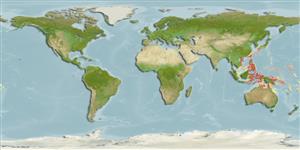Classification / Names
Common names from other countries
Main reference
Size / Weight / Age
Max length : 4.1 cm SL male/unsexed; (Ref. 84001)
Environment
Marine; benthopelagic; depth range 5 - 30 m (Ref. 84001)
Climate / Range
Subtropical, preferred ?
Distribution
Short description
Dorsal
spines
(total): 7;
Dorsal
soft rays
(total): 9-10;
Anal
spines: 1;
Anal
soft rays: 9. This species is unique from its congeners by having the following characters: lacks a filamentous spine on the first dorsal fin (the third spine subequal in length to preceding spine); 19-20, typically 20 pectoral-fin rays; head and most of nape no scales, predorsal scales absent; pelvic fins fused medially with well developed connecting membrane and frenum; fifth segmented ray of pelvic fin 91.8-94.9% of preceding ray in length; below the eye faint, dusky blotches (not forming vertical bar); distal tip of first dorsal fin with a black blotch, wide, extending posteriorly to middle or more posterior part of third interspinal membrane; sensory papilla rows x^1 and x^2 not continuous, interrupted by row trp; sensory papilla rows trp extending dorsally to slightly above a longitudinal line through rows x^1 + x^2; anterior tip of sensory papilla row b extending or not to row 4 and well apart from row (Ref. 84001).
IUCN Red List Status (Ref. 115185)
Threat to humans
Harmless
Human uses
More information
Common namesSynonymsMetabolismPredatorsEcotoxicologyReproductionMaturitySpawningFecundityEggsEgg development
Age/SizeGrowthLength-weightLength-lengthLength-frequenciesMorphometricsMorphologyLarvaeLarval dynamicsRecruitmentAbundance
ReferencesAquacultureAquaculture profileStrainsGeneticsAllele frequenciesHeritabilityDiseasesProcessingMass conversion
Tools
Special reports
Download XML
Internet sources
Estimates of some properties based on models
Phylogenetic diversity index
PD50 = 0.5625 many relatives (e.g. carps) 0.5 - 2.0 few relatives (e.g. lungfishes)
Trophic Level
3.2 ±0.3 se; Based on size and trophs of closest relatives
Resilience
High, minimum population doubling time less than 15 months (Preliminary K or Fecundity.)
Vulnerability
Low vulnerability (11 of 100)
Price category
